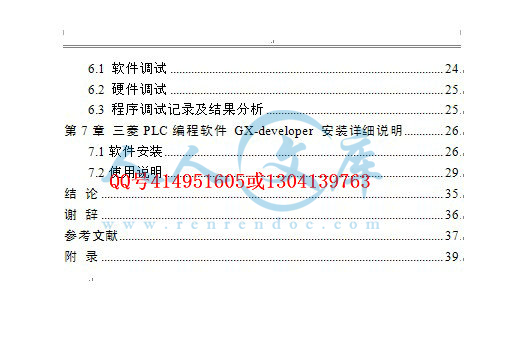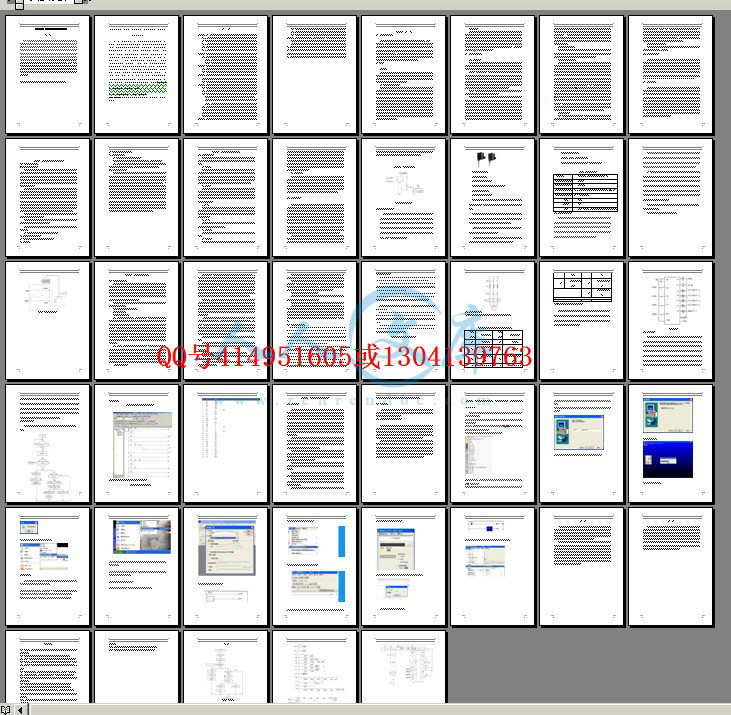【温馨提示】 购买原稿文件请充值后自助下载。
以下预览截图到的都有源文件,图纸是CAD,文档是WORD,下载后即可获得。
预览截图请勿抄袭,原稿文件完整清晰,无水印,可编辑。
有疑问可以咨询QQ:414951605或1304139763
基于PLC 控制的水塔水位设计
摘 要
PLC 控制方案在硬件基础上配合软件实现了低警戒水位报警、并可切换手动/自动两种工作方式。利用高可靠性的PLC系统实现水塔水位的自动控制从而提高水塔供水的可靠性。包括:水位的检测、PLC的选型、PLC输入/输出接口回路的设计、PLC对水泵电机的控制等多个方面。供水是一个关系国计民生的重要产业。随着社会的发展和人民生活水平的提高,对城市供水提出了更高的要求,要满足及时、准确、安全保证充足供水,如果仍然沿用人工方式,劳动强度大,工作效率低,安全性难以保障,为此必须进行水塔水位控制自动化系统的改造。可编程控制器( PLC) 因其高可靠性和较高的性价比在工业控制中得到广泛的应用。本文针对目前比较流行的控制技术,利用PLC和传感器构成了水塔水位恒的控制系统。改造后的水塔水位自控系统,实现水塔水位自动控制系统,远程监控,实现无人值守。
关键词:可编程逻辑控制器(PLC),水塔水位,自动控制
PLC-based level design of the water tower
ABSTRACT
The PLC control scheme with software to realize the low water level warning alarm, and can switch to manual / automatic two kinds of work mode on the basis of hardware. Realization of automatic control of water level by using PLC system with high reliability and improve the reliability of water supply. Including: the detection of the water level, selection of PLC, PLC input / output interface circuit design, PLC of the pump motor control etc.. Water supply is a major industry relationship beneficial to the people's livelihood. With the development of society and the improvement of people's living standard, put forward higher request to the city water supply, to meet the timely, accurate, safe to ensure adequate water supply, if still use manual mode, high labor intensity, low efficiency, difficult to ensure the safety of the water tower, reform must be carried out control automation system. Programmable logic controller (PLC) because of its high reliability and high cost performance has been widely used in industry control. Aiming at the control of the most popular techniques, using PLC and sensor control system of constant water tower water level. Water tower control system after the transformation, the realization of automatic control system, remote monitoring of water tower water level, to achieve unattended.
KEY WORDS: programmable logic controller (PLC), water tower, automatic control
目 录
第1章 前 言1
1. 1 PLC的基本概念1
1. 2构成1
1. 3 PLC的工作原理2
1.4 PLC的技术原理4
1. 5 PLC的优点4
第2章 水塔水位的发展与应用5
2.1 水塔水位的发展5
2.1.1 水塔水位的历史5
2.1.2 水塔水位的应用6
第3章 水塔水位的方案选择7
3.1 系统方案论证7
3.2 PLC的选择8
第4章 系统电路设计9
4.1水位传感器的选择9
4.2 系统结构原理图11
第5章 系统程序的编制14
5.1 PLC的工作原理14
5.2 PLC梯形图概述16
5.3 输入/输出分配18
5.3.1列出水塔水位控制系统PLC的输入/输出接口分配表18
5.3.2 水塔水位系统的输入/输出设备19
5.4 工作过程20
5.5程序流程图21
5.6梯形图22
5.7水塔水位控制系统梯形图的对应指令表22
第6章 系统维护与故障处理24
6.1 软件调试24
6.2 硬件调试25
6.3 程序调试记录及结果分析25
第7章 三菱PLC编程软件 GX-developer 安装详细说明26
7.1软件安装26
7.2使用说明29
结 论35
谢 辞36
参考文献37
附 录39
第1章 前 言
1. 1 PLC的基本概念
早期的可编程控制器称作可编程逻辑控制(Programmable Logic Controller, PLC),它主要用来代替继电器实现逻辑控制。随着技术的发展,这种采用微型计算机技术的工业控制装置的功能已经大大超过了逻辑控制的范围,因此,今天这种装置称作可编程控制器,简称PC。但是为了避免与个人计算机(Personal Computer)的简称混淆,所以将可编程序控制器简称PLC,PLC自1969年美国数据设备公司(DEC)研制出现,现行美国,














 川公网安备: 51019002004831号
川公网安备: 51019002004831号